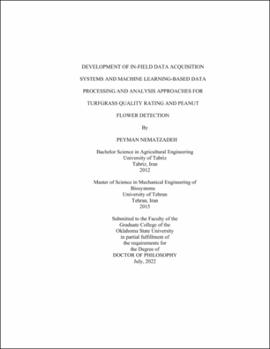| dc.contributor.advisor | Wang, Ning | |
| dc.contributor.author | Nematzadeh, Peyman | |
| dc.date.accessioned | 2023-04-05T16:21:08Z | |
| dc.date.available | 2023-04-05T16:21:08Z | |
| dc.date.issued | 2022-07 | |
| dc.identifier.uri | https://hdl.handle.net/11244/337306 | |
| dc.description.abstract | Digital image processing and machine vision techniques provide scientists with an objective measure of crop quality that adds to the validity of study results without burdening the evaluation process. This dissertation aimed to develop in-field data acquisition systems and supervised machine learning-based data processing and analysis approaches for turfgrass quality classification and peanut flower detection. The new 3D Scanner App for Apple iPhone 12 Pro's camera with a LiDAR sensor provided high resolution of rendered turfgrass images. The battery life lasted for the entire time of data acquisition for an experimental field (49 m × 15 m size) that had 252 warm-season turfgrass plots. The utilized smartphone as an image acquisition tool at the same time achieved a similar outcome to the traditional image acquisition methods described in other studies. Experiments were carried out on turfgrass quality classification grouped into two classes (“Poor”, “Acceptable”) and four classes (“Very poor,” “Poor,” “Acceptable,” “High”) using supervised machine learning techniques. Gray-level Co-occurrence Matrix (GLCM) feature extractor with Random Forest classifier achieved the highest accuracy rate (81%) for the testing dataset for two classes. For four classes, Gabor filter was the best feature extractor and performed the best with Support Vector Machine (SVM) and XGBoost classifiers achieving 82% accuracy rates. The presented method will further assist researchers to develop a smartphone application for turfgrass quality rating. The study also applied deep learning-based features to feed machine learning classifiers. ResNet-101 deep feature extractor with SVM classifier achieved accuracy rate of 91% for two classes. ResNet-152 deep feature extractor with the SVM classifier achieved 86% accuracy rate for four classes. YOLOX-L and YOLOX-X models were compared with different data augmentation configurations to find the best YOLOX object detector for peanut flower detection. Peanut flowers were detected from images collected from a research field. YOLOX-X with weak data augmentation configurations achieved the highest mean average precision result at the Intersection over Union threshold of 50%. The presented method will further assist researchers in developing a counting method on flowers in images. The presented detection technique with required minor modifications can be implemented for other crops or flowers. | |
| dc.format | application/pdf | |
| dc.language | en_US | |
| dc.rights | Copyright is held by the author who has granted the Oklahoma State University Library the non-exclusive right to share this material in its institutional repository. Contact Digital Library Services at lib-dls@okstate.edu or 405-744-9161 for the permission policy on the use, reproduction or distribution of this material. | |
| dc.title | Development of in-field data acquisition systems and machine learning-based data processing and analysis approaches for turfgrass quality rating and peanut flower detection | |
| dc.contributor.committeeMember | Weckler, Paul | |
| dc.contributor.committeeMember | Long, John | |
| dc.contributor.committeeMember | Alderman, Phillip | |
| dc.contributor.committeeMember | Wu, Yanqi | |
| osu.filename | Nematzadeh_okstate_0664D_17862.pdf | |
| osu.accesstype | Open Access | |
| dc.type.genre | Dissertation | |
| dc.type.material | Text | |
| dc.subject.keywords | deep feature extraction | |
| dc.subject.keywords | deep learning | |
| dc.subject.keywords | peanut flower detection | |
| dc.subject.keywords | supervised machine learning | |
| dc.subject.keywords | turfgrass quality classification | |
| thesis.degree.discipline | Biosystems Engineering | |
| thesis.degree.grantor | Oklahoma State University | |
